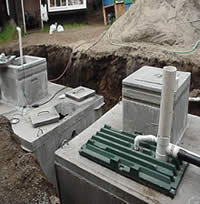Contact EPA Pacific Southwest Groundwater
Pacific Southwest, Region 9
Serving: Arizona, California, Hawaii, Nevada, Pacific Islands, Tribal Nations
Underground Injection Control (UIC)
| Underground Injection Control (UIC) Quick Finder | ||
|---|---|---|
| Ground Water HomeUIC Home | Cesspools in HawaiiClass V Wells | UIC PermitsOnsite Sewage Treatment |
National Links
Resources
- Seepage Pits May Endanger Ground Water Quality (PDF) (2 pp, 63K)
- Onsite Sewage Treatment: Maintenance Checklist (PDF) (2 pp, 63K)
- Tribal Management of Onsite Wastewater Treatment Systems (PDF) (4 pp, 429K)
- Alert for RV, Boat, and Mobile Home Owners and Park Operators (PDF) (2 pp, 374K)
- Class V Well Types
Onsite Sewage Treatment
Septic systems and more advanced onsite wastewater treatment technologies rely on soil to complete treatment of sewage and sanitary wastewater before dispersing it into the environment. In some areas of Region 9, onsite systems have contributed to ground water degradation, most notably with nitrates. Nitrate contamination of aquifers may also be indicative of the potential for movement of other contaminants, such as viruses, from onsite systems to the water table. Such instances generally result from improper design or operation of onsite technologies, such as overly dense placement of systems, inappropriate depth or type of soil, or inappropriate loading of wastewater.
When properly sited, constructed, operated and maintained, onsite wastewater treatment systems should not threaten water quality. Where these systems provide higher levels of treatment, they may actually serve as a valuable source of aquifer recharge (check state and local reuse standards).
When is an onsite wastewater treatment system a Class V well?
At least one of these criteria must be met:
- The system has capacity to serve 20 or more persons per day.
- The system receives non-sanitary waste, such as that generated by manufacturing, chemical processing, industrial fluid disposal, automotive repair or recycling, or if the system receives sewage containing biocidal agents (such as sewage from recreational vehicles or portable toilets.)
If you own or operate a system that meets one of these criteria, you must submit inventory information using this online form , or, if you prefer to mail it to EPA, use Form 7520-16: Inventory of Injection Wells (PDF, 3 pages, 108 KB) and mail it to the UIC program contact for your area.

NOTE: Single family residential septic systems receiving only sanitary waste are not regulated as Class V injection wells but are subject to local and state regulations.
Local and state regulations apply to onsite wastewater systems throughout Region 9. Injection well owners are responsible for determining all applicable requirements for their system. In addition to the inventory requirement noted above, all onsite sewage treatment systems must comply with the non-degradation requirement found at 40 CFR part 144.12. No other specific federal requirements apply to these systems, however, EPA may impose further requirements (e.g., permitting on a case-by-case basis).
EPA does provide guidance on the management of systems to ensure environmental and public health protection. For more information, please see the EPA Septic Systems topic. EPA’s partner organizations, including the National Small Flows Clearinghouse, can be accessed through that site.
Other Publications
Seepage Pits May Endanger Ground Water Quality (PDF) (2 pp, 63 K)
Onsite Sewage Treatment: Maintenance Checklist (PDF) (2 pp, 88K)
Tribal Management of Onsite Wastewater Treatment Systems (PDF) (4 pp, 429 K)
Alert for RV, Boat, and Mobile Home Owners and Park Operators (PDF) (2 pp, 374 K)
Contact information
For additional information regarding Class V activities, contact one of the following:
On tribal land:
Aaron Setran (Setran.Aaron@epa.gov)
(415) 972-3457
or
Emmanuelle Rapicavoli (rapicavoli.emmanuelle@epa.gov)
(415) 972-3969
In Hawaii:
Kate Rao (rao.kate@epa.gov)
(415) 972-3533
In all other locations or for general information:
Liz Janes (janes.elizabeth@epa.gov)
(415) 972-3537
